This post contains affiliate links. As an Amazon Associate I earn from qualifying purchases. View our Privacy Policy.
How to bake the best cookies from scratch involves mastering the baking basics. If you want to charm the hearts of your friends and family, do it with a cookie. Because who doesn’t love these scrumptious treats?
Whether you’re looking to brush up on your cookie-baking knowledge or become a better cookie chef, you’re at the right place.

Why Are My Cookies Flat? How To Prevent Cookies From Spreading
If you ever felt the underwhelming letdown of flat cookies, you probably opened yourself up to an oven of bites flat as your heart hitting the ground.
If you’re asking yourself, “Why are my cookies flat?” there’s no need to get heated up over spilled milk.
There’s no one single answer to why your cookies are flat. Try troubleshooting your flat cookies for these common baking mistakes.
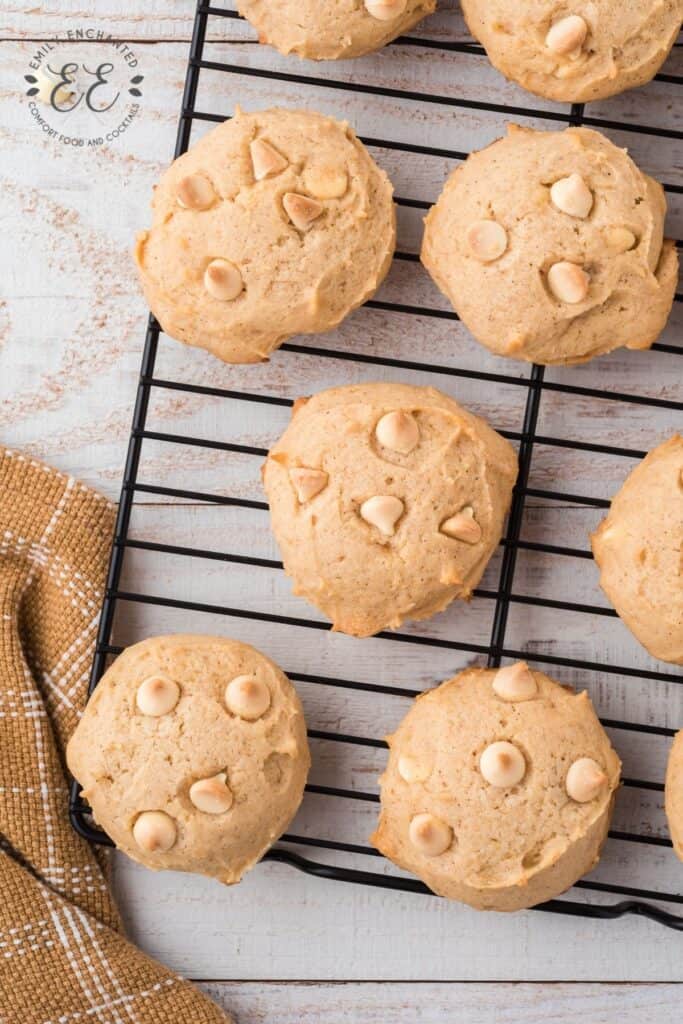
Eggnog Cookies inspired by everyone’s favorite holiday drink!
What causes cookies to flatten is warm temperatures. The longer you leave cookie dough out at room temperature, they will continue to turn into a wet and greasy glob of slime. How long should you refrigerate your cookie dough before baking? The longer the better, but one hour minimum in the fridge should do the trick.
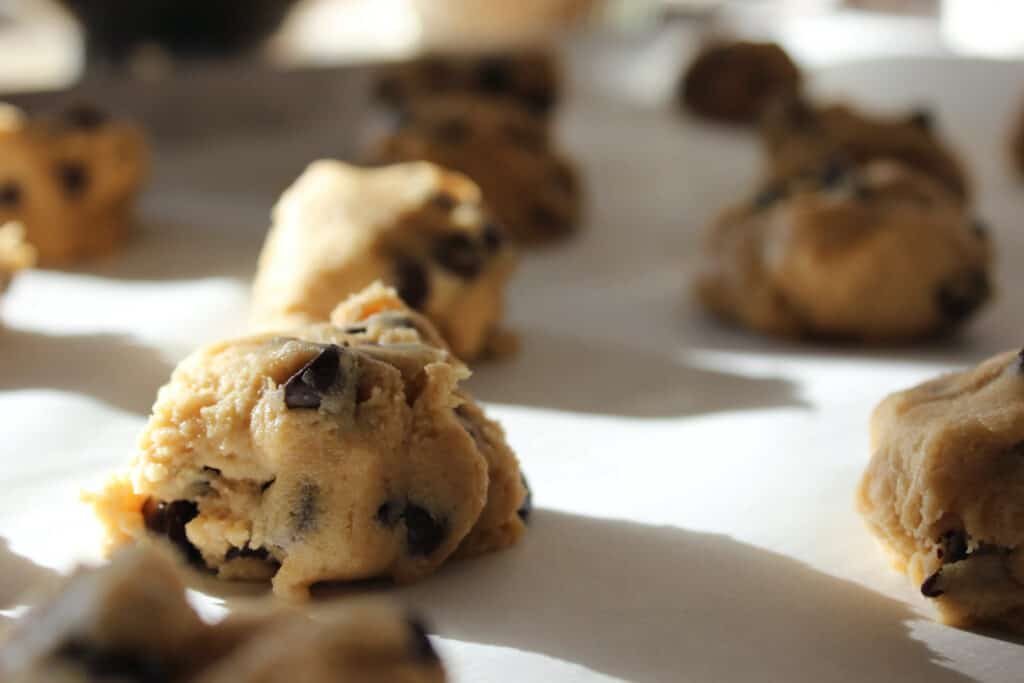
Fat content (butter)
Think of baking like chemistry. Solids have a stronger hold than liquid forms. The same goes for butter and its temperature. Butter at cooler temperatures will keep your cookies in retained shape. Whereas warm butter in cookie dough will be in a weaker semi-liquid state, causing your cookies to flatten. How do you know if butter is at room temperature? It should hold its shape upon pressing. And if it looks shiny or greasy, it’s likely warmer than room temperature.
Bonus butter tip: always use butter over margarine when baking cookies. Why? Margarine has more water and less fat than butter, which will lead to thin (and easily burned!) cookies.
Add more flour
Cookies flatten because of the fat content such as butter melts from the oven heat. To hold that fat content together, a binding agent like flour will keep your cookies intact. If you find your cookies still flat after adding the right measurements, don’t be afraid to add more flour sparingly.
Use the right raising agent
Cookies won’t bake properly if you’re using good-quality baking soda or baking powder. Make sure your baking soda or baking powder is fresh (not expired) and ready to use. Baking powder is a better leavening agent than baking soda due to having an acidic compound to make the cookies rise.
Don’t over-grease your baking sheets
If you combined the right measurements and ingredients, your cookies should have enough fat to keep them from sticking onto your baking sheet. Besides, the best baking sheets are nonstick. So be aware of leftover grease from a previous batch or over-greasing your baking sheets superfluously.
Bonus baking sheet tip: If you will be reusing baking sheets between batches, make sure your baking sheets cool down to room temperature first. Hot grease or fat from the previous batch will begin to flatten your cookies before they reach the oven.
How To Save Flat Cookies
It takes one magic item to save flat cookies: a spoon. Rather than discarding your cookies to waste, reshape your warm cookies. Because the cookies are still warm, they are still soft for fixing.
- Retrieve the baking sheet from the oven with your oven mitts.
- Use a spoon to push the edges of the cookies back towards the center of each cookie.
- Place the baking sheet in the oven to resume baking again.
- Repeat the necessary steps if you find your cookies spreading out again.
If you already took your cookies out of the oven and they cooled down, don’t throw them out just yet. You can resort to re-purposing the delicious bites instead of leaving them to waste.
- Crush your flattened cookies into a crumbled mixture to use as a topping for a thick milkshake or ice cream.
- Make mouth-watering ice cream sandwiches.
- Crumble your cookies and add as a topping to a sweet chocolate bark recipe.

Don’t want to waste your flat cookies? Get creative and sprinkle the crumbles as toppings on desserts for the holidays like Santa’s Trash Cookies.
Other Quick Fix Cookie Fails
If you followed your recipe instructions but still can’t seem to get it right, here are some quick fixes to consider:
- How come my cookies baked together? Your cookies were placed too close to each other. Add more spacing between each cookie dough.
- How come my cookies are burned? Adjust your temperature and keep tracking of timing. An aluminum baking sheet also helps to reflect heat away from the cookies.
- Why are my cookies puffy and cakey? There is too much air in the dough from mixing. Bring your cookie dough to room temperature before placing them in the oven.
- Why are my cookies hard? Reduce flour, add an egg, or store them in an airtight container during the cooling process.
- Why did my cookies stick to the baking sheet? They have been placed too long to cool down. Place them back in the oven to warm (but not bake again) for a few minutes to soften.
The Best Oven Rack Position For Baking Cookies Evenly
Most ovens have two to three racks to place baking trays. If you’re asking yourself in the kitchen, “where should I bake my cookies in the oven?” For consistent and all-around even texture for perfect cookies, use the middle rack. Why? Baking your cookies in the middle exposes your cookies to obtain a steady flow of air, heat, and circulation.
Baking your cookies on the bottom rack of the oven makes your cookies more susceptible to burning quickly close to the heat source.
Whereas baking your cookies at the top rack of the oven away from the heat source will prolong the cooking time of your cookies. This makes them vulnerable to spreading more.
For perfectly baked cookies, patience is your best friend. That means one baking sheet in the oven at a time placed horizontally on the middle rack of the oven. About three quarters into your baking time, rotate the baking tray around for consistency.
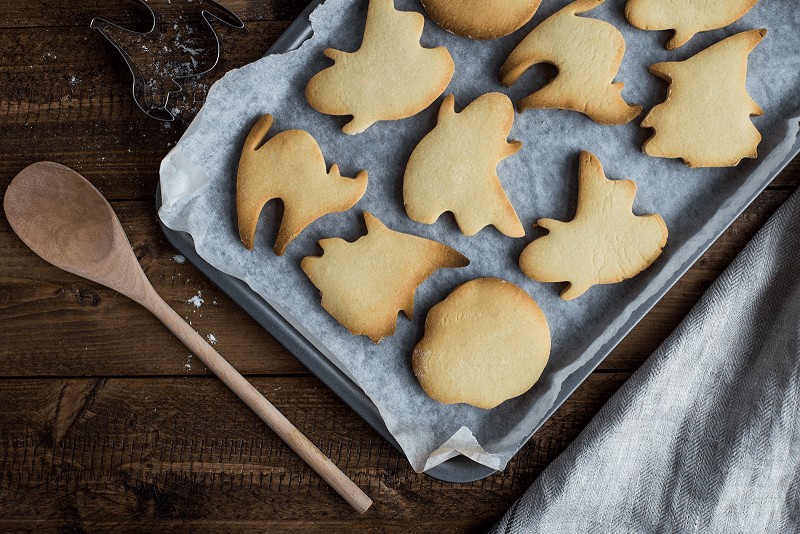
An example of burned cookies placed at the button rack of an oven.
Can I Bake 2 Trays of Cookies at the Same Time?
In an ideal world, sometimes we don’t have the time and resources to follow the best cookie baking protocols. That means breaking the rules, beating time, and baking 2 trays of cookies at the same time. While this is possible to do, keep in mind the potential outcomes due to trade-offs.
If you’re going to bake 2 trays of cookies at the same time:
- Place one baking sheet in the middle rack and the other on the top rack.
- Add an extra 2 to 3 minutes of baking time.
- Replace both baking sheets in each others’ place at the midpoint of your baking time.
For example, if you are baking Christmas cookies for 18 minutes with two baking sheets, your total baking time is 20 minutes. And you would switch both baking trays at 10 minutes.
Essential Cookie Baking Ingredients
For how to bake the best cookies, you’ll need to have an understanding of the basic ingredients you mix. Here’s a breakdown of essential cookie baking ingredients to help you get those to-die-for cookies.
Flour
All-purpose wheat flour is used as a primary ingredient when baking cookies. The wheat within the flour is what gives the cookies structure. If you’re gluten intolerant or are looking for a different type of flour, check out the 5 best substitutes for all-purpose flour.
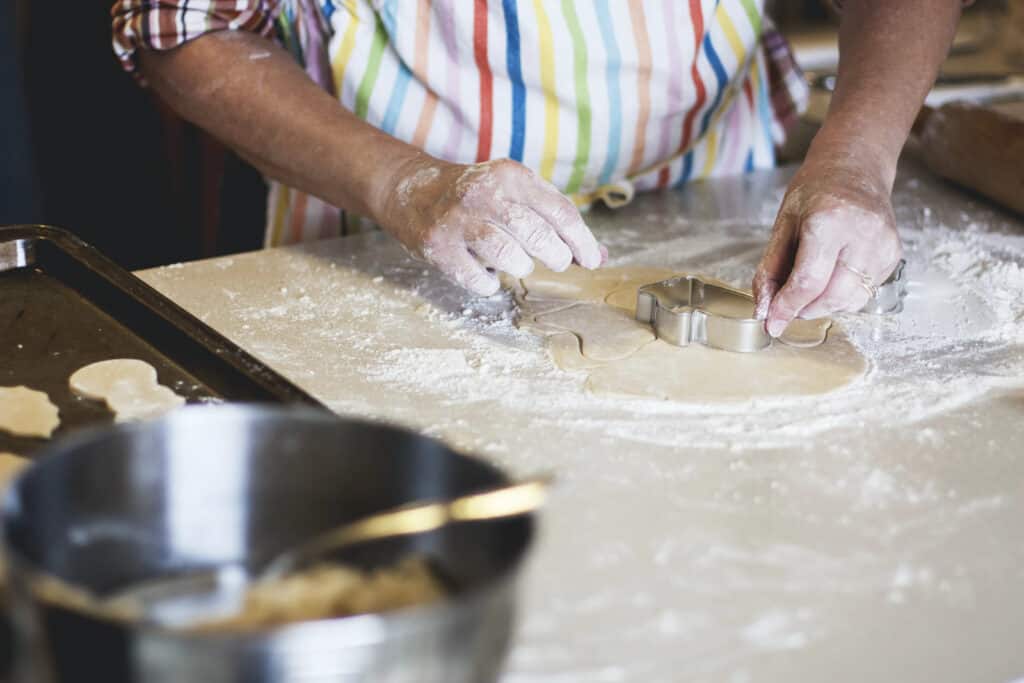
Sugar
It’s the key ingredient for what makes cookies a delightful treat by satisfying your sweet tooth. Sugar for baking comes in three forms: dry (granulated or fine), liquid, or syrup. Sugar not only adds a sweet taste to your cookies, but it locks in moisture to prevent your cookies from drying too quickly.
There are also other colored sugars like soft light or dark brown sugars. These types of sugars have a stronger flavor due to molasses being added back during processing. It boils down to your personal preference based on what sugar you want to use for strength in taste.
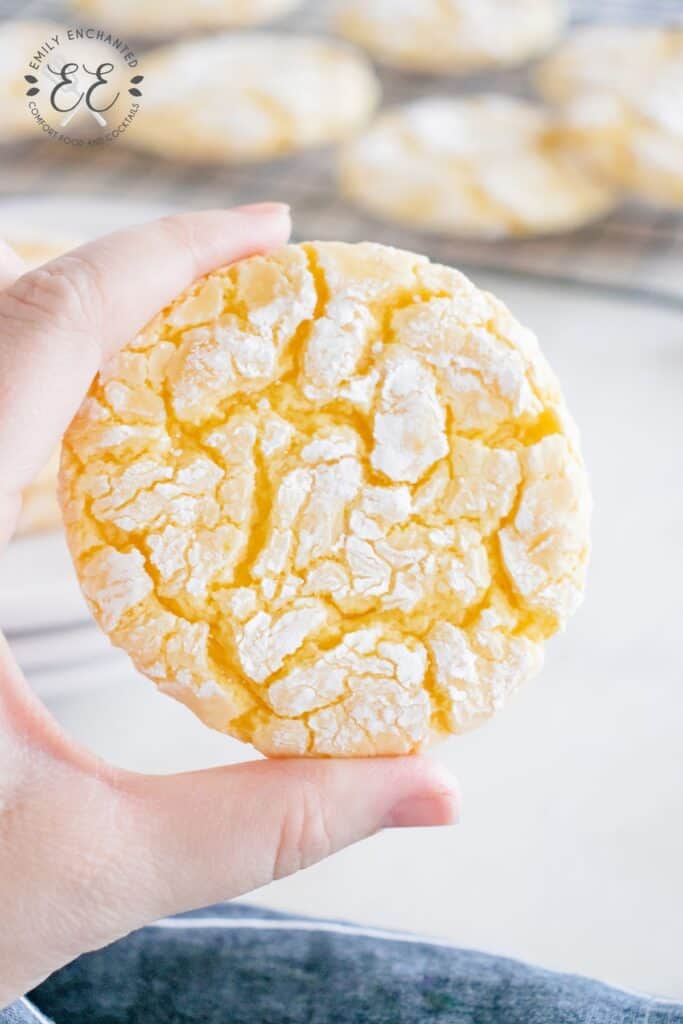
Easy to bake Lemon Snowflake Cookies that decorate with powdered sugar. Perfect for the holidays!
Butter
The most obvious use for butter in baking is adding rich flavor. Whipped butter has too much air being light in texture, which can lead to inaccurate measurements and flat cookies.
Raising or Leavening Agents
Baking soda and baking powder are the most common leavening agents used in baking and shouldn’t be confused with each other. Baking powder consists of baking soda, cream of tartar (acidifying agent), and sometimes starch (drying agent). On the other hand, baking soda is pure sodium bicarbonate. The purpose of leavening agents serves to add lightness in texture (causing rise) and enhance the color of your baked goods. Leavening agents don’t have a long shelf-life, thus it is important to store them properly in an airtight container for up to 3 months upon opening.
Oils
Cooking oils in baking help your cookies become lighter and moister. If you want chewy or drier cookies, use little oil.
Baking oils that have a neutral flavor and high smoke point: canola, vegetable, corn
Baking oils that have distinctive flavor: coconut, avocado
Other notable baking oils to try: sunflower, peanut safflower
Cornstarch
Made from finely ground corn kernels into a powdery starch, cornstarch serves as a thickening agent when baking cookies. The starch molecules unravel when baked in the oven in the presence of moisture. This is what causes your cookies to swell or gelatinize.
Eggs
Eggs add structure to your baking in the form of protein that mixes with other ingredients like flour and starches. When the ratio of eggs to sugar and fat content is greater, you will achieve tough and chewy cookies. Unless stated otherwise in cookie recipes, use large grade-A hen eggs. Eggs serve as a rising agent in cookie recipes to replace the evaporated moisture content.
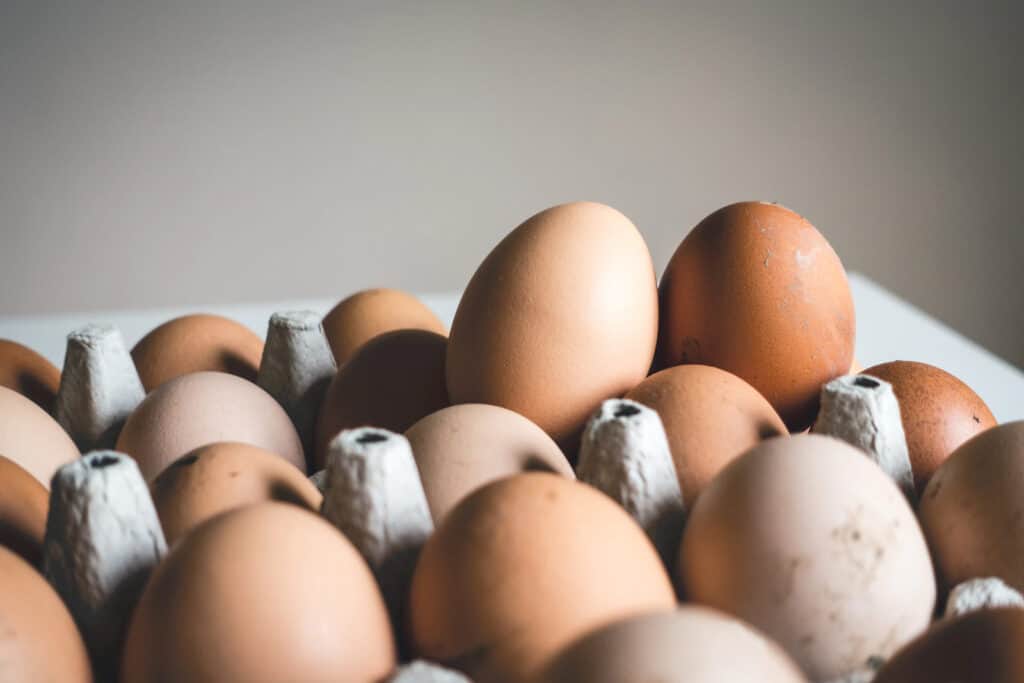
Salt
Unlike eggs, flour, or sugar – salt has little to no impact on the structure when baking cookies. For example, bake one batch of cookies with salt and another batch without salt. While both batches will look exactly alike, but one batch will taste wrong. Salt in baking serves as a flavor enhancer and takes out bitter tastes.
Recommended salts for baking are the ones you prefer to your taste buds. Though, careful not to add too much salt to make an overpowering salty batch.

Cream of Tartar
Cream of tartar acts as a bonding agent for egg whites to hold the ingredients of your cookies together as a stabilizer. Cream of tartar is also a white powdery leavening agent made as a byproduct of the wine-making process. Because it has similar baking properties as other leavening agents, it will lose its potency over time. Thus storage for cream of tartar is important.
5 Extra BONUS Tips On Baking Cookies
- Perform a test batch before you go all in so you don’t waste your ingredients.
- Keep your eggs are room temperature to have your cookies rise.
- Avoid overbeating eggs that give your cookie dough too much air. This leads to flat cookies.
- Use a baking paper or baking mat. No one likes burnt cookies!
- Invest in an oven thermometer for accurate temperatures to prevent baking mishaps. Check out this article for other home baking safety tips.
CONCLUSION
Now that you know the best tips on how to bake the best cookies, go bake yourself the perfect batch you crave! To avoid faulty cookie batches, it is important to follow the recipe’s ingredient and measurement instructions.
Get that apron on and start baking delicious cookies!
Why not start with these flavorsome and easy cookie recipes:
